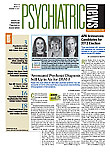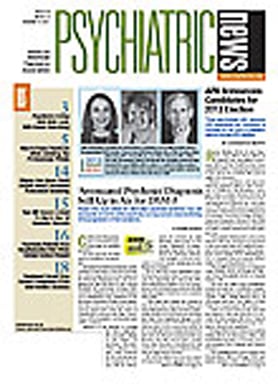Criteria describing symptoms of attenuated psychosis may be included in DSM-5.
Or they may not. Or they may be included in an appendix.
Attenuated psychosis syndrome (APS), a category that seeks to describe individuals experiencing distress from symptoms of delusions, hallucinations, and disorganization that fall short of the clinical threshold for psychosis, is being field-tested for inclusion in the revised manual to be published in 2013. Members of the Psychotic Disorders Work Group emphasize that it is by no means certain that the criteria, which have been the source of considerable attention and some controversy, will be included—or if so, how they will be included.
Addition of the disorder is perhaps the most high-profile potential change the chapter on psychotic disorders. Other changes that have been proposed by the work group are the inclusion of a rating scale for dimensions of severity in nine domains, elimination of the classic "subtypes" of schizophrenia that have been featured in previous editions, and changes to the way catatonia is treated across conditions in the diagnostic manual.
In an interview with Psychiatric News, work group member Rajiv Tandon, M.D., said that regarding the criteria for APS, the work group members were not unanimous in recommending inclusion, but felt that the category deserved to be tested in field trials.
"The basic idea behind the concept is that by the time someone is diagnosed with schizophrenia, there has been considerable decline in social function and there may have been significant damage to the brain," Tandon said. "The field recognizes that we have to try to intervene earlier, if we can identify those at high risk and if we have safe and effective treatments that can decrease that risk. And we have a model from other branches of medicine for risk syndromes, such as hypercholesterolemia, that are aggressively treated."
He said the subject has been the source of controversy from opposite directions. "On the one hand are those who say there is going to be overdiagnosis of kids who might never go on to develop psychosis but who will unnecessarily be treated with antipsychotics," Tandon remarked. "And on the other hand are those, especially in academic research, who say, 'How can you not include this category? This is a frontier of psychiatry. This is the future.' "
Tandon suggested that the criteria may not necessarily be included in the main text of the manual, but in the appendix. "The bottom line is that the work group could not make a final recommendation one way or another, but believed that the criteria should receive further study in field trials," he said.
The uncertainty about the criteria is reflective of a subject that has garnered enormous research interest in the last five years and much promise, but about which there are still unresolved questions. For instance, Tandon noted that across the 12 to 15 centers in the U.S. and Europe that have developed criteria for identifying individuals at risk for psychosis, the rates of conversion to psychosis have been falling from over 40 percent, when studies first began, to between 15 percent and 27 percent (Psychiatric News, May 20).
It is a phenomenon that has challenged researchers to rethink diagnostic boundaries and the specificity of measures used to define someone as "at risk" for psychosis.
Moreover, Tandon said the work group was also compelled to reconsider the concept of a "risk syndrome" and to focus instead on symptoms that cause current and ongoing distress or disability—a conceptual realignment reflected in the term "attenuated psychosis syndrome," which replaces the previous name of "psychosis risk syndrome."
Tandon noted that though the criteria are identical, the new term represents "more than a name change, but a change in the construct itself" for describing subthreshold symptoms. "We moved away from the idea that these were symptoms that put an individual at risk for something that has not happened yet to the idea that these symptoms are causing distress now," he said.
So the criteria emphasize that the attenuated symptoms of delusions, hallucinations, and disorganization must be present in the past month and occur at an average frequency of at least once a week in the past month, must have begun in or significantly worsened in the past year, and must be sufficiently distressing and disabling to the patient and/or parent/guardian to lead them to seek help (see
Highlights of Proposed Changes to DSM-5 Psychotic Disorders).
If included in the text, Tandon said there would need to be extensive education around the fact that people who meet criteria for APS may not necessarily convert to active psychosis, but may warrant close monitoring without routine treatment with antipsychotics. In the meantime, he stressed the need to dispel assumptions that a decision has already been made. "The only decision has been that this is something we need to explore further."
Less dramatic but representing a break with the past is the proposal by the work group to eliminate the "classic" subtypes of schizophrenia—paranoid, disorganized, catatonic, undifferentiated, and residual. Tandon said that with the exception of the paranoid subtype, the subtypes are very rarely used clinically. Furthermore, these subtypes have limited diagnostic stability, poor validity, and little clinical utility, he said.
Additionally, the work group proposes that criteria for "catatonia"—which can occur across a variety of psychiatric disorders—be simplified and consolidated, so that they are identical wherever they appear in the manual. And the work group has proposed that catatonia be included as a "specifier"—a specific feature that may occur secondary to another disorder—across conditions.
Finally, the work group has proposed including a 0-4 rating scale (4 representing the most severe) for nine dimensions of psychotic symptomatology: delusions, hallucinations, disorganization, restricted emotional expression, avolition/asociality, impaired cognition, depression, mania, and psychomotor symptoms. The proposal is part of a movement generally in the development of DSM-5 toward a "dimensional approach," reflecting emerging research evidence that different disorders share certain features—which may vary in severity from patient to patient—potentially expressive of common genetic endophenotypes.
Some of the elements might be consolidated and fewer dimensions might ultimately be recommended, Tandon said.
"A different rating on different dimensions would indicate a different approach to treatment," Tandon said. "If positive psychotic symptoms of delusions and hallucinations are very severe, it might indicate aggressive treatment with antipsychotics. If negative and cognitive symptoms are severe, it might indicate an entirely different therapeutic approach."
Comprehensive information about potential changes to criteria for schizophrenia and psychotic disorders is posted at < www.dsm5.org/ProposedRevision/Pages/SchizophreniaSpectrumandOtherPsychoticDisorders.aspx >.
Highlights of Proposed Changes To DSM-5 Psychotic Disorders
Criteria for attenuated psychosis syndrome (APS) are currently being field tested. They may be included in the main text of the manual, in the appendix, or not at all. No decision has been made yet. These are the criteria for APS:
A. Delusions, hallucinations, or disorganized speech in attenuated form with intact reality testing but of sufficient severity or frequency that it is not discounted or ignored.
B. Symptoms must be present in the past month and occur at an average frequency of at least once a week in the past month.
C. Symptoms must have begun in or significantly worsened in the past year.
D. Symptoms must be sufficiently distressing and disabling to the patient and/or parent/guardian to seek help.
E. Symptoms are not better explained by any DSM-5diagnosis, including substance-related disorder.
F. Criteria for any DSM-5 psychotic disorder have never been met.
Inclusion of a four-point rating scale for severity in nine dimensions: delusions, hallucinations, disorganization, restricted emotional expression, avolition/asociality, impaired cognition, depression, mania, and psychomotor symptoms.
Elimination of classic subtypes of schizophrenia.
Simplification and consolidation of criteria for catatonia, so that they are similar in the sections of the manual in which they appear, and inclusion of catatonia as a specifier across the
DSM.


